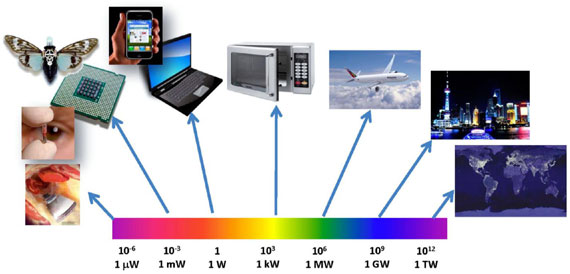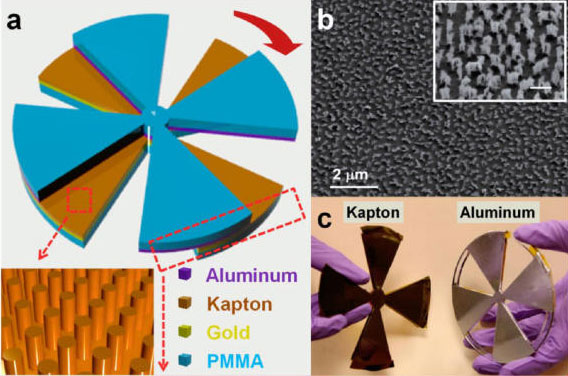| Posted: Nov 19, 2013 | |
Nanotechnology for self-powered systems |
|
| (Nanowerk Spotlight) There is an almost infinite number of mechanical energy sources all around us – basically, anything that moves can be harvested for energy. These environmental energy sources can the very large, like wave power in the oceans, or very small, like rain drops or biomechanical energy from heart beat, breathing, and blood flow. With the increasing use of nanotechnology materials and applications in energy research, scientists are finding more and more ways to tap into these pretty much limitless sources of energy. | |
| The continued miniaturization of portable electronics is increasingly challenged by the reliance on conventional battery technology. But for the near future, micro- and even nanoscale devices will be widely used in health monitoring; infrastructure and environmental monitoring; internet of things; and of course defense technologies. In these application areas, battery design will have to go way beyond today's typical lithium-ion batteries (read more: "Nanotechnology T-Shirt to replace batteries? Towards wearable energy storage"). Rather than relying on stored power, nanodevices will probably rely on novel, also nanoscale, power sources. | |
 |
|
| Magnitude of power and its corresponding applications. Macroscale energy is for powering a city and even a country; nanoscale energy is to power tiny small electronics. Both applications are measured by different characteristics. (© American Chemical Society) | |
| Self-powered nanotechnology based on piezoelectric nanogenerators aims at powering nanodevices and nanosystems using the energy harvested from the environment in which these systems are suppose to operate. This offers a completely new approach for harvesting mechanical energy using organic and inorganic materials. | |
| Zhong Lin Wang, a professor at Georgia Institute of Technology, originally coined the term nanopiezotronics to describe the coupled piezoelectric and semiconducting property of nanowires and nanobelts for designing and fabricating novel electronic devices such as nanotransistors and nanodiodes. | |
| In previous Nanowerk Spotlights we showed examples of how nanogenerators can be "powered by ultrasonic waves, convert heartbeat and breathing into electricity, and harvest waste energy from a rotating tire. In an intriguing demonstration, Wang's lab has also shown that the technology offered by nanogenerators can be used for large-scale energy harvesting. | |
| Wang's team – which has been developing nanogenerator technology since 2006 – already has demonstrated that nanogenerators can be driven by irregular mechanical motion, such as the vibration of vocal cords, flapping of a flag in the breeze, tapping of fingers, hamsters running on exercise wheels or the conversion of biomechanical energy into electricity by a muscle-movement-driven nanogenerator (read more: "Nanotechnology converts heartbeat and breathing into electricity"). | |
| Back in 2011, to provide a comprehensive and coherent review about the development of nanogenerators, Wang has published a free e-book – Nanogenerators for Self-powered Devices and Systems – mainly based on his group's published papers. The purpose of the book is to provide a coherent coverage about nanogenerators from fundamental materials, basic physics principles and theory, scientific approach, engineering-scale up and technological applications, so that readers can get a full picture about the development of this technology. The entire 139-page book is composed of 11 chapters with hundreds of figures. | |
| In a recent review article, published online in ACS Nano ("Triboelectric Nanogenerators as New Energy Technology for Self-Powered Systems and as Active Mechanical and Chemical Sensors"), Wang gives an up-to-date summary about the fundamentals of the triboelectric nanogenerator (TENG) – a device that converts mechanical energy into electricity using the coupling effects between triboelectrification and electrostatic induction through the contact separation or relative sliding between two materials that have opposite tribo-polarity – and its updated progress and potential applications as a new energy technology and as self-powered active sensors. | |
| In other words, TENG is a physical process of converting mechanical agitation to an electric signal through the triboelectrification (in inner circuit) and electrostatic induction processes (in outer circuit). | |
| After addressing the fundamentals of triboelectrification and traditional triboelectric generators, which go back to the 1880s, Wang goes into great detail to explain the fundamentals as well as the characterization of triboelectrification at the nanoscale and the operating principle of various forms of TENG such as vertical contact-separation-mode-based TENG, lateral sliding-mode-based TENG, rotation-mode-based TENG, and single-electrode-based TENG. | |
 |
|
| Rotating triboelectric nanogenerator (TENG) in segmented disk configuration. (a) Schematic illustration showing the structure design of the disk TENG. The inset (bottom left) is an enlarged figure showing the Kapton nanorod array created on the surface area. (b) Top view SEM image of the Kapton nanorods showing its uniformity in a large range. The inset is a high-magnification SEM image of the Kapton nanorods in 30° tilted view. The scale bar is 500 nm. (c) Photograph showing the two parts of a real disk triboelectric nanogenerator. (© American Chemical Society) | |
| He also reviews potential applications and some of the practical devices that his team fabricated in the past – harvesting vibration energy, harvesting energy from human body motion, TENG as self-powered active strain/force sensors, TENG as self-powered active chemical sensors, and water-surface-based TENG for chemical sensors. | |
| Concluding hie review, Wang states that the future of triboelectric nanogenerator technology is about material and device hybridization. "The self-powering idea is a new paradigm in nanotechnology for truly achieving sustainable self-sufficient micro/nanosystems, which are of critical importance for sensing, medical science, infrastructure and environmental monitoring, defense technology, and even personal electronics. Therefore, nano is not only beautiful but, more importantly, nano has to be useful! Nanotechnology has the obligation to solve some of the critical problems facing the sustainable development of the world. This has to be the goal of nanotechnology now and in the future." | |
 By
Michael
Berger
– Michael is author of three books by the Royal Society of Chemistry:
Nano-Society: Pushing the Boundaries of Technology,
Nanotechnology: The Future is Tiny, and
Nanoengineering: The Skills and Tools Making Technology Invisible
Copyright ©
Nanowerk LLC
By
Michael
Berger
– Michael is author of three books by the Royal Society of Chemistry:
Nano-Society: Pushing the Boundaries of Technology,
Nanotechnology: The Future is Tiny, and
Nanoengineering: The Skills and Tools Making Technology Invisible
Copyright ©
Nanowerk LLC
|
|
|
Become a Spotlight guest author! Join our large and growing group of guest contributors. Have you just published a scientific paper or have other exciting developments to share with the nanotechnology community? Here is how to publish on nanowerk.com. |
|
